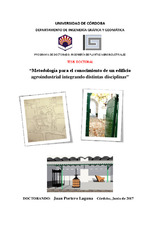Mostrar el registro sencillo del ítem
Metodología para el conocimiento de un edificio agroindustrial integrando distintas disciplinas
| dc.contributor.advisor | Montes Tubío, Francisco de Paula | |
| dc.contributor.advisor | Ruz Ortiz, José Jaime | |
| dc.contributor.author | Portero Laguna, Juan | |
| dc.date.accessioned | 2017-09-18T06:47:18Z | |
| dc.date.available | 2017-09-18T06:47:18Z | |
| dc.date.issued | 2017 | |
| dc.identifier.uri | http://hdl.handle.net/10396/15067 | |
| dc.description.abstract | La preocupación por el conocimiento y la conservación del patrimonio cultural ha ido aumentando de manera significativa en la sociedad a lo largo de los últimos años. En el terreno de la arquitectura el interés se ha extendido de los monumentos con una inequívoca significación histórica, a las diferentes expresiones de la cultura popular, incluyendo las construcciones urbanas y agrícolas que acumulan entre sus muros vestigios representativos de la historia cultural del entorno en el que se ubican. El estudio de todas las dimensiones histórico-culturales de estas construcciones (educativa, religiosa, política, agraria, industrial, etc.) es de vital importancia si se quieren elaborar propuestas y programas orientados a la conservación de sus funciones, o bien a su reutilización para nuevos usos relacionados con el sector del ocio, el turismo y la hostelería. En este sentido el presente trabajo se centra en el estudio de la evolución de un edificio que se construyó en el siglo XVI bajo el patrocinio de la segunda marquesa de Priego, en la localidad cordobesa de Montilla, y que en el transcurso de más de cuatro siglos pasó de colegio a taberna-bodega, experimentando diferentes transformaciones intermedias. En primer lugar el edificio fue utilizado durante más de dos siglos como colegio de los Jesuitas, hasta que éstos fueron expulsados de España por el rey Carlos III. Los Jesuitas construyeron en el edificio una primitiva iglesia. Posteriormente el conjunto se transformó en convento franciscano, hasta la desamortización de Mendizábal en 1835, año en que el convento pasa a manos particulares y la iglesia al obispado de Córdoba. Una parte del edificio del convento la adquiere en 1.904 el médico jerezano D. Francisco Palop, que constituirá en ella la primera agrupación socialista montillana, denominada La Parra Productiva. Durante los últimos años del siglo pasado los locales de la agrupación socialista se transforman en lagar, bodega y taberna. El paso por el primigenio Colegio de personalidades como San Francisco Solano, San Juan de Ávila, cuyos restos se conserva en la iglesia del edificio, y D. Diego de Alvear y Ponce de León, entre otros, permite que estudiemos su relación con el Colegio tomando como hilo conductor las reformas del edificio. | es_ES |
| dc.description.abstract | Concerns about knowledge and conservation of cultural patrimony increased in significant manner in the society in the last few years. In the field of architecture the interest extended from monuments with special historic significance to different expressions of popular culture, including the urban and agricultural buildings that accumulate among their walls representative vestiges of the cultural history of their environment. The study of all historic and cultural dimensions of these buildings (educative, religious, politic, agrarian, industrial, etc.), becomes of paramount importance if we want to elaborate proposals and programs aiming to preserve their functions, or else to their re-utilization for new uses related with the leisure, tourism and hotel sectors. In this sense the present work focuses in the evolution of a building that was constructed in the XVI century, sponsored by the second marquise of Priego, at Montilla's Cordovan city. The building was used over two centuries like a high school of Jesuits, until these were thrown off Spain by the king Carlos the third. The Jesuits constructed at the building a primitive church. At a later time the building turned into Franciscan convent, until the Mendizábal's disentailment in 1835. In this year the convent passed to private hands and the church to bishopric of Córdoba. A part of the building of the convent is acquired in 1,904 by the doctor Francisco Palop. Mr. Palop will constitute in the building the Montilla's first socialist group, called the Productive Grapevine. Great figures of that time such as San Francisco Solano, San Juan de Avila and Mr. Diego de Alvear and Ponce de León studied in the school of Jesuits. We will research their relationship with the school as a common thread for studying the evolution of the building. | es_ES |
| dc.format.mimetype | application/pdf | es_ES |
| dc.language.iso | spa | es_ES |
| dc.publisher | Universidad de Córdoba, UCOPress | es_ES |
| dc.rights | https://creativecommons.org/licenses/by-nc-nd/4.0/ | es_ES |
| dc.subject | Arquitectura rural | es_ES |
| dc.subject | Patrimonio cultural | es_ES |
| dc.subject | Lagar | es_ES |
| dc.subject | Bodega | es_ES |
| dc.subject | Taberna | es_ES |
| dc.subject | Rural architecture | es_ES |
| dc.subject | Cultural heritage | es_ES |
| dc.subject | Winepress | es_ES |
| dc.subject | Winery | es_ES |
| dc.subject | Tavern | es_ES |
| dc.title | Metodología para el conocimiento de un edificio agroindustrial integrando distintas disciplinas | es_ES |
| dc.type | info:eu-repo/semantics/doctoralThesis | es_ES |
| dc.rights.accessRights | info:eu-repo/semantics/openAccess | es_ES |

